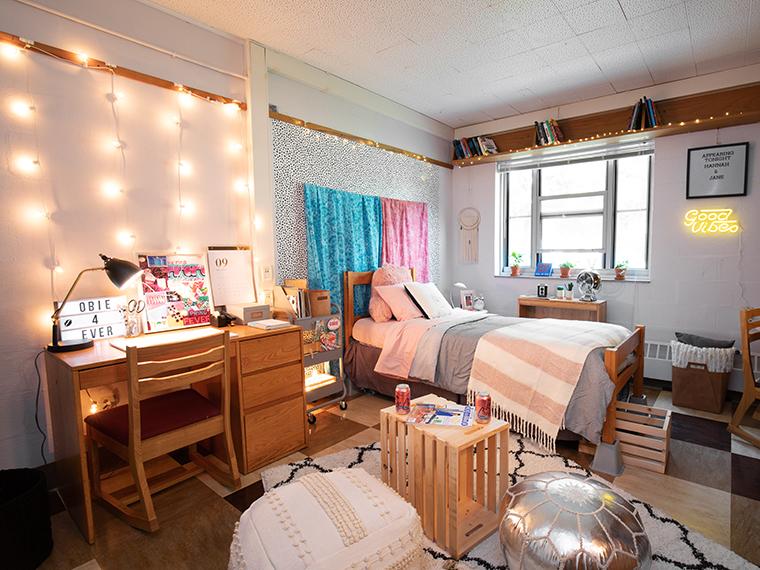Dorm Room Design in a Pandemic: Apartment Therapy Founder Maxwell Ryan ’89
August 21, 2020
Hillary Hempstead

An Oberlin dorm room decorated by Maxwell Ryan '89.
Photo credit: Tanya Rosen-Jones
The former designer and founder of Apartment Therapy, a go-to home decor site and media company, talks dorm room design tips for students, paying particular attention to the opportunities and challenges that the COVID-19 pandemic presents. This story follows a feature on Ryan in the fall 2018 issue of the Oberlin Alumni Magazine, in which he transformed a room in Barrows Hall.
For Oberlin students this year, the dorm may play its most important role ever. With capacity limits placed on campus spaces and students assigned single-occupancy rooms to slow the spread of the coronavirus, students will likely spend more time in their dorm room than in the past. While it’s no question there will be challenges, there are also some bright spots—an entire dorm room for one!
We asked Maxwell Ryan to revisit the topic of dorm room design and offer more advice on how to make a dorm room the coziest, most welcoming place possible. Read on for Ryan’s tips on dorm design in these new circumstances.
Bring your old home to your new home
In his earlier collaboration with the Oberlin Alumni Magazine, Ryan offered tips on how to decorate a dorm room. “When we last talked, I said ‘go shopping,’” says Ryan. “This time, I say don’t go shopping—bring your home with you.” Ryan notes that this is not a year to introduce brand new decor. Instead, students should decorate or work with what they have been living with for the last six or seven months to foster a feeling of home. “Bring your comforter from your bedroom,” he says.
He suggests that another way to recreate that homey feeling is to bring artwork or other mementos. “It’s vital to bring things that aren’t just functional; make sure to bring meaningful items from home, including art or photos. “If I had to leave my apartment right now, I could lose almost everything and not cry,” he says. “But it’s the artwork—things that my mother painted or that I bought from a friend—that are the most important.”
Create distinct spaces in your room
This year, students will be assigned a dorm room without another roommate. In this arrangement, it’s likely that many rooms will still contain enough furniture for at least two students. Ryan believes this extra room is actually a boon for designing the space. He notes that because students will be spending so much time in their rooms, they’ll want to view their room the way they would an entire home. “Students can program the different parts of the room,” says Ryan. “Create a living room, a dining room, a study area, and a bedroom. Dedicate areas for different functions, and keep them that way. And don’t work in your bed; reserve your bed for the nighttime.”

While some may see this as overly structured, he says it’s important to take this approach to use the entire space. “Moving yourself around the room throughout your day will likely make you a great deal happier,” he says. But if you just can’t bear working anywhere other than your bed, Ryan makes one recommendation: buy a bed table or lap desk.
As for how to deal with the extra furniture, Ryan has some suggestions. “Turn the other bed into a couch and use the area as a living room. You can sit there and hangout. When it comes to schoolwork, one desk can be for working—that’s your office—and the other can be a virtual hangout spot with photos and pictures. For the closets, one can house your clothes, and the other can be a mudroom to store things from outside.”
Light it up
Pandemic or not, Ryan says that one of the most important things to consider in a space is the light. “When a person walks into a room, their eye first travels to the points of light. That movement around the room is the movement that you take into your body. It’s the movement that makes you feel the energy of the space,” he says.
Unfortunately, the lighting in dorm rooms is typically harsh—particularly the overhead fluorescents. To create a welcoming and cozy space, Ryan recommends leaving the overhead light off and instead adding at least three other points of light. He suggests a clip-on light for the desk, string lights for a warm glow all throughout the room, and a floor lamp in the lounge area. “The more light sources, the less likely you have to turn on your overhead light,” says Ryan.
Ryan also recommends arranging your study area so that your desk is near the natural light of the window. “Sleep in the shadow, work in the light,” he says.
Make space for headspace
It’s also important to consider how to support a students’ emotional and mental health through room design. While the weather is nice, students will have opportunities to connect with friends out of doors. But as the weather turns colder, it may prove more difficult to spend time with others. Ryan says that because of this, students should have a dedicated area in their room for quiet reflection and thinking.
“Having an altar for meditation or journaling can be useful,” says Ryan. “You’ll want to check in with yourself often and take more care than usual.”
You may also like…
Josh Nolan Named Vice President, General Counsel, and Secretary at Oberlin
Distinguished attorney brings extensive experience in higher education law.
Learning by Teaching: Oberlin Students Share Global Music with Young Learners
College and Conservatory students in PACE 103 prepare local children for an immersive community concert at Oberlin.
Nuiko Wadden ’02 Joins Oberlin Conservatory Faculty as Assistant Professor of Harp
The versatile musician brings extensive opera, orchestral, and contemporary music experience to her role


